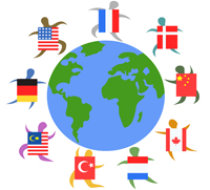Methods for meaningful intercultural dialogue in the North Caucasus
On December 20th, Victoria Galyapina, candidate of science (Ph.D.), associate professor of Stavropol State University, made a presentation on “Methods for meaningful intercultural dialogue in the North Caucasus” in the ILSCR.
The North Caucasus Federal District has a sophisticated, diverse ethnic composition, concentrated on a relatively small area, which makes a direct dependence of the state of the political situation on the situation in the sphere of international relations. The current socio-political and ethno-political situation in the North Caucasus Federal District has a number of expressed negative social trends, manifestations of ethno-political and religious extremism, as well as conflict-high potential.
Victoria Galyapina described several studies in which she was involved as a director or performer of the project aimed at reducing tensions between ethnic groups. The themes of the studies were the following: relations between police and young members of public organizations; the problem of domestic violence; Islamic education in the North Caucasus. The researchers point out that religion in the North Caucasus is beginning to play an important role not only in the education, but in the social and personal life of each person, as well as in the political and public relations. A high urgency of the problem of domestic violence, especially against women, in the North Caucasus was revealed. The younger generation is showing its willingness to apply in such cases to specialists, psychologists, and to employees of public organizations.
Victoria Galyapina listed the principles used in the development of forms and methods of building effective intercultural dialogue. It’s creating a situation of interdependence, equal status of ethnic groups, friendly atmosphere, establishing informal contacts between members, creation of conditions for the maintenance of standards of equality. The projects were aimed at reducing intergroup comparison, stereotyping, negative feelings associated with group membership, and intergroup interaction. The researchers started from the fact that the formation of ethnic tolerance correlated with a positive ethnic identity and a higher level of identity within ethnic groups. The researchers used the following methods: joint training and professional development; joint interregional activities, meetings, events, social engineering, trainings of ethnic tolerance and effective conflict resolution, methods of art therapy, forum-theater, networking, creation of a joint website.
Victoria Galyapina reported on numerous projects in the North Caucasus, which have been used successfully identified methods. These projects are aimed at building the capacity of educational institutions (especially schools) in the area of formation of ethno-cultural competence and ethnic tolerance, improving the professional competence of psychologists in the police, professional development of horizontal cross-cultural contacts. Within the projects, there were trainings of ethnic tolerance and ethnocultural competence, and the trainers were forming constructive intercultural dialogue between the children of the North Caucasus through creative activities.
Olga Pavlenko
Date
20 December
2012
Topics
Keywords

